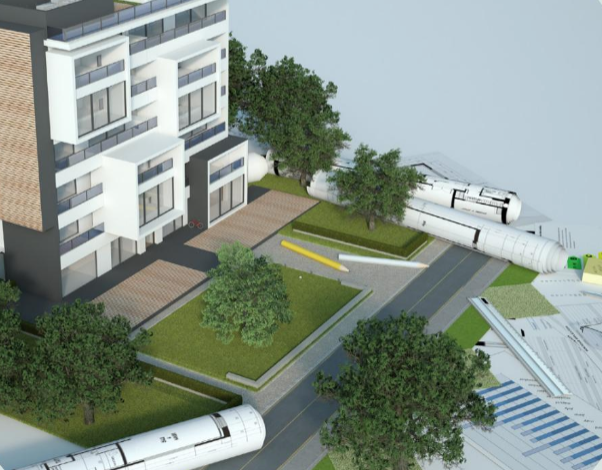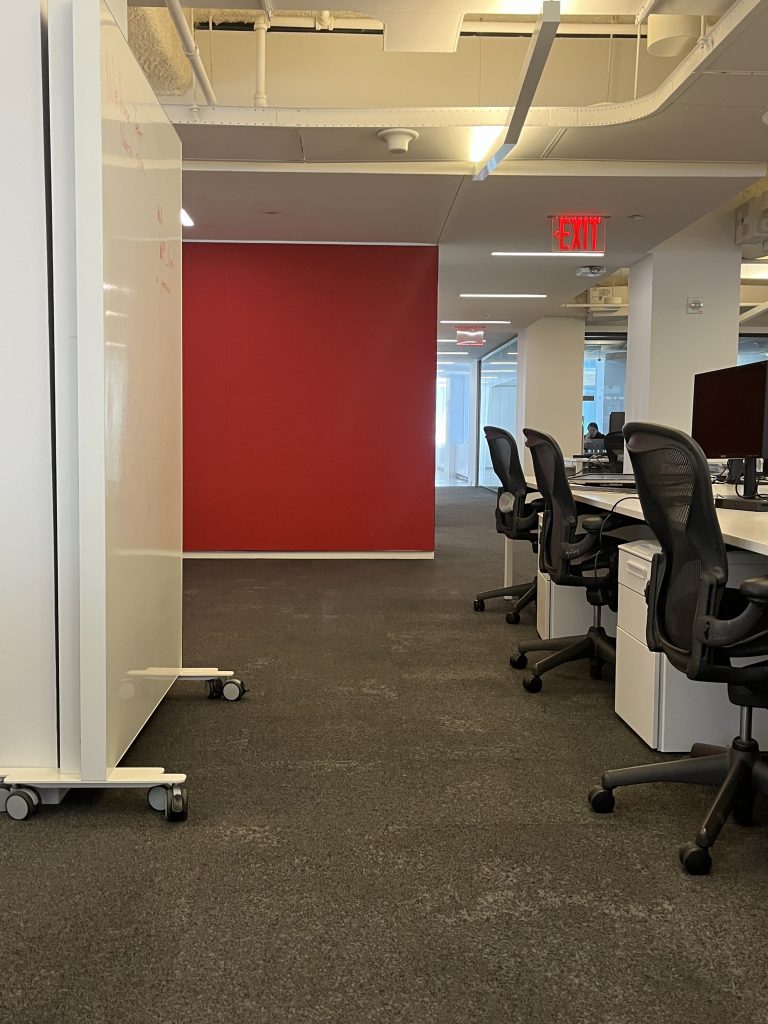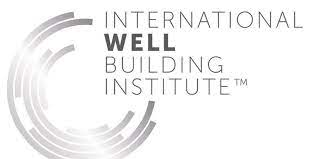The pandemic, inflation, and rising energy costs are taking many commercial construction projects in new directions as owners prioritize energy efficiency and healthy workspaces.
That’s creating opportunities for contractors who are well-versed in building to performance-based standards such as LEED, WELL Building, and Passive House (also known as Passivhaus).
Techniques that previously might have been considered too expensive now are getting second looks as there is a bigger opportunity for owners to achieve a return on their investment sooner.
“I do think that the development market is so tight right now they want the cost savings related to energy, they want the savings related to health,” said Michael Kuhn, president of Jendoco Construction Corp. in Pittsburgh.
For example, building owners whose multi-year contracts are ending with electricity suppliers are finding themselves facing large increases when they renew, increases they had not budgeted for.
“We’re getting calls saying, ‘What can we do?’” said John Hayden, director of engineering for Quandel Energy Solutions in Harrisburg. “Lighting projects make a lot of sense. We’re seeing a lot more interest in solar.”
“It’s a no-brainer to do some of this stuff,” he said.
Going green
Requests to “tune-up” existing buildings also are rolling in.
“Some of my simplest projects and best-performing projects are reusing existing equipment and tuning the systems up so they work more efficiently and effectively,” Hayden said.
Some buildings were constructed using LEED or WELL Building concepts, but the owners opted not to go through the third-party certification process, resulting in them not performing as well as they could.
“Performance is where it’s at,” Hayden said. “I’ve done projects on really efficient buildings that are run poorly because they weren’t commissioned. They got to 99% complete but not 100%. And that last 1% is making sure the building’s systems are operating in the way they were intended to.”
So, I do that last 1%, and suddenly I can take a building that has the potential to perform really well and cut the energy by half.”

Updated lighting, new windows, more efficient toilets and updated HVAC systems can pay off. Replacing 20-year-old lighting can reduce costs by 50% to 60%. Tuning up dampers and replacing aging temperature sensors can pay big dividends on utility bills. Lighting and toilet upgrades can recoup the investment costs through lower utility bills in about seven years or less, Hayden said.
The legislation backing the movement
The Inflation Reduction Act that was enacted in August includes provisions that should further boost energy-efficient and green construction as demand for it grows.
The law includes money to update local energy codes and incentives to make it less expensive for developers to use sustainable building materials. It includes more than $5 billion in incentives to drive the incorporation of low-carbon materials into public projects including infrastructure and government buildings.
The legislation also expands tax deductions for some commercial buildings that are made more energy efficient.
Technology is making it easier to build better, too, including renovation projects that previously would have been considered cost prohibitive.
Aeroseal, an aerosol-based sealant that is blown into duct work to seal openings, has greatly improved the performance of aging HVAC systems that would have cost millions more to replace, Hayden said. A project a few years ago at a Pennsylvania correctional facility reduced leakage by 90% and saved the facility an estimated $7,000 a year.
How the market is reacting
More owners are pursuing projects built using sustainable techniques not only because of their desire to save on energy costs and create a healthy space, but because they recognize climate changes, too. Colder periods of cold, greater humidity levels and an increasing number of large rainfall events are driving interest.
“Generally, we’ve seen a desire for projects to want to be tuned into these latest ways of thinking,” said Marc Mondor, AIA, principal and co-founder of evolveEA, a green building and sustainability consulting and design firm based in Pittsburgh who is vice chair of the Pennsylvania Climate Change Advisory Committee.
There is more interest in sustainable construction in sectors such as higher education, health care and nonprofits, Kuhn said. They recognize they must do that to be competitive, but they also have altruistic goals and want to be leaders in their communities. The efforts can pay off for nonprofits because their good intentions can motivate donors.
“That resonates, it truly does,” said Kuhn, a LEED Accredited Professional.
For commercial projects, sustainability is part of the conversation, but sometimes it’s in a different context, trumped by concerns about value.
“The key is to look at that as an investment”
Mondor
“Yeah, it costs more but you get a return. You can get a financial return typically, and that’s easily justifiable or determinable through energy modeling. But you can also get returns with regards to better indoor air quality, better health for employees, less turnover, more happiness with the building, so fewer callbacks. So, there’s a return that’s beyond just the financial.”
It’s up to contractors to reconcile the value and help owners to recognize the return on investment they can achieve through a concept such as WELL Building, Kuhn said.
“It’s pretty easy for owners to be interested in but it is also a bit daunting when you look at the operational aspects of it and the auditing aspects of it,” he said. “Similar to LEED, people want to do good things and the right things, but on some level, the upfront costs for certifications, the auditing, and those types of things are less appealing to owners, and so the conversation then turns into that of, ‘we just want to do all of those things, but we don’t care about getting the certification.’”
With design-build projects becoming more common and architects having greater influence on projects in the early stages, it’s important for architects to be aware of sustainable building concepts so they can bring them forward early in the process, said Mondor, a past president of AIA Pennsylvania who is a WELL Accredited Professional and is licensed by the U.S. Green Building Council to teach LEED Basics.
“The earlier you can design those things, the smoother the project’s going to go, and the higher value contractors are going to be able to offer owners,” he said. “If you decide these things early, then everything flows from that. It’s a great way to minimize waste.”
And it’s up to contractors to have the knowledge to implement projects that are planned to standards such as WELL Building, PassivHaus, and LEED.
“Contractors who have decided to get really good at this or learn a lot about it or assign somebody to really take it seriously have tended to do well,” Mondor said.
“If they don’t do it, their competitors will.”
He provides consulting services, advising contractors about how to handle such projects, what they need to do and what the expectations are. His firm has managed Living Building Challenge (LBC), WELL Building, and LEED certifications for more than 100 projects.
The increased interest in designing and constructing buildings that emphasize the health of occupants and indoor air quality is prompting more professionals to become certified in WELL Building.
They include Katie Walsh, a registered architect who is a project manager at the Pittsburgh office of SmithGroup, an integrated architecture, engineering, and planning firm.
“What I liked about WELL was it incorporated science into the design,” said Walsh, who is a WELL accredited professional (WELL AP).
Jendoco Construction Corp. recently sent three team members to get certified in Passive House construction.
“You have to really understand the science involved in those details to be able to construct it properly because if you don’t, and you don’t construct it properly, then it fails,” Kuhn said. “For somebody who’s not in the dance right now, you need to go out and learn the systems so you can be a good collaborative value upfront.”
Stringent oversight is needed to make sure all requirements are met, ranging from how materials are secured to how waste is disposed of. Subcontractors must be trained on what materials, down to the paint and caulking, are appropriate.
WELL building, LEED or Passive House
“On a project that is WELL Building, LEED and Passive House, if you don’t have very strict quality control, things can go bad very quickly,” Kuhn said. “Particularly in a WELL Building where there’s auditing done, in Passive House where there’s testing done, there’s a lot more risk involved if you don’t have the quality control during construction.”
Where WELL Building differs from LEED is the need to be able to evaluate different optimizations and goals, not just from a construction and cost standpoint, but considering whether they make sense for the client or end user, Kuhn said.
“It starts with understanding what those systems are. If you don’t know what’s involved with WELL Building, there’s a lot of places where you can go to understand it and figure out what the role is,” he said.
While LEED is a building process with the environment in mind, WELL building is a process with people in mind. It is based on principles and techniques to design spaces that improve physical and mental health.
In about the past four years, the square footage of certified WELL space has grown more than 10 times, from about 3 million square feet in 2018 to 4 billion in 2022, according to the International WELL Building Institute.
The concept exploded amid the COVID-19 pandemic, as companies sought to create safe places for people to work and live.
There are seven standards: air quality, water quality, nourishment, light, fitness, comfort, and mind.
In 2020, the Desmone Architects building in Pittsburgh became the first WELL Gold Certified building in Pittsburgh and only the sixth WELL Certified space in Pennsylvania at the time.
Jendoco Construction Corp. was the contractor on the project, which Kuhn described as “the absolute pinnacle of how the collaborative approach can create success.”
He said Chris Klehm, a pioneer in sustainable construction who currently is Jendoco’s vice president of sustainability, worked closely with Desmone CEO Chip Desmone and President Eric Booth to put the project together.
Desmone couldn’t have timed the opening of its new building any better. It was completed about a year before the pandemic.
“We were kind of accidentally brilliant,” Desmone said.
“We at that point basically had one of the healthiest, cleanest buildings in Pittsburgh to occupy. I think it’s helped people get comfortable with returning to work and feeling a sense of safety and security in knowing that the building is focused on their health in its design.”
Desmone learned about WELL Building nearly a decade ago from the Design and Health Leadership Group of the American Institute of Architects. It struck him as “the future, or the next greatest thing, with regards to how architects can influence this intersection between design and human health.”
The WELL-certified section of its building, about 8,000 square feet, was constructed as an addition to what previously was a parking lot. It was built with non-VOC materials and is cleaned daily with unscented cleaners that do not emit chemicals.
Impacting employees
It has plentiful windows to allow for natural light. Photometric studies were done to ensure each workspace had sufficient lighting. Water stations are located throughout the building to encourage team members to drink plenty of water. Sound masking technology keeps workspaces quiet.
Air quality is monitored in real time and shown on a computer screen that everyone can see. Fruit and healthy snacks are provided in a large dining area where staff is encouraged to gather instead of eating at their desks.
The stairs are larger than required by code and are located more prominently than the elevator to encourage walking. The stairs are marked with calorie-burn counts to show the impact that walking has. Plants are plentiful.
“The incremental increase in employee satisfaction multiplied over 30 years going forward is significant, and it adds great value to the company,” Desmone said. “It solidifies our commitment to our people and our culture. It reduces turnover, which reduces the cost of onboarding new employees, and it just builds a better business for us. And in the end, that’s what we want and that’s what we want to be able to share with our employees.”

That’s a selling point for project owners to consider as they design their buildings.
Contractors don’t have to be specialists to take on a WELL project, Booth said.
“If the contractor is familiar with LEED, it’s not a big jump,” he said. “If you’ve got a contractor that’s used to doing quality work in a quality way, it is not going to be difficult to pick up. It’s just a matter of learning things and getting used to the standards and protocols and so forth. Any contractor that’s worked on high-performance buildings or LEED, this should not be a stretch.”
It’s important to point out that in order to do this effectively, there has to be a really strong partnership between all those involved in the project – owner, design team, contractor, from the beginning. Because a lot of the concepts have to do with construction itself, waste management, air quality, and so forth, the contractor really needs to be on the same page going into it,” Booth said.
WELL buildings can cost about 5% to 8% more.
“It’s not significant. The payback is notable for the quality of life it brings to the culture of your workspace. I think that payback is worth every penny,” Desmone said.
As Desmone Architects designs buildings for its clients, it introduces them to WELL techniques if they are not familiar with them and offers its building as a lab for interested parties to visit.
Many WELL concepts will be familiar to anyone in the design field.
“A lot of techniques we’ve been doing as designers for eons – natural light and so forth. The difference with WELL is that WELL actually puts measurements behind this. They actually did studies where they said this is the amount of light that’s good, this is the maximum amount of particles that should be in the air or in the water in order for it to become acceptable,” Booth said.
To achieve certification, projects must pass testing by the International WELL Building Institute and go through a renewal process every three years.
“It requires us to live it. That accountability was something that really spoke to us,” Booth said.
WELL Building has really caught on, Mondor said.
“We’re seeing more WELL buildings for clients who want to show that they are doing what they can for the environment or for users to come into the building and take pride in working there.”
Passive House construction concepts also are growing in popularity, Mondor said.
“Some of the benefits of Passive House are the energy performance is really good, but it also makes the spaces much quieter. You’re not getting any exterior noise. And, they’re so well-built that they’re far more durable.”
Passive House construction continues to be used most widely in residential projects, but some commercial projects are adopting it, including branches of the Carnegie Library in Pittsburgh.
“It’s heartening to see Passive House being applied to larger commercial buildings,” Mondor said.
The largest demand for sustainable projects is occurring in Pennsylvania’s urban areas, he said. It’s taking longer to catch on in rural areas, partly because there just aren’t nearby, affordable options for drywall recycling, wood mulching, metal smelting, masonry crushing, and other requirements to repurpose materials.
Net zero construction – buildings that generate more energy than they use over a 12-month period – also are becoming more popular, Mondor said. They typically use solar panels to create energy, selling any excess back to the grid through Pennsylvania’s net metering process.
Walsh is hopeful that another emerging building technique, mass timber, will catch on.
It uses engineered wood products – thick, compressed layers that can be used for load-bearing walls and floors and roofs – that are environmentally friendly because they are not as carbon-intensive. The material can create efficiencies in the construction process, which is a significant contributor to carbon emissions.
Mass timber is being used more often in housing construction along the West Coast but will take some time to become an economical option in Pennsylvania, she said.
“I think it’s going to be a game changer if we could start to get that rolling,” Walsh said. “It’s happening on the coast, and I think coming into Pennsylvania would be interesting not only in design but also in our construction processes.”
Community impact
Sustainable building practices also are opportunities to improve equity within communities and break down barriers, Walsh said.
For example, harmful air pollution recently was linked to bad urban planning policies from nearly 10 decades ago. Though some policies were outlawed 50 years ago, their repercussions remain, Walsh said, especially in marginalized neighborhoods that can be five degrees or hotter due to less green space, more paved surfaces, and lack of cooling elements. In addition to those environments being uncomfortable to live in, they also contribute to poor environmental air quality.
“There’s an urban infrastructure that needs to be updated,” Walsh said. “And I think how we build better also has to layer in addressing historic planning policies and evolving our construction and architectural processes.”
I think incorporating where your project’s materials are coming from, who is building it and designing it is part of being sustainable,” she said. “How are we building a better city? It’s not just ‘green’ – I think there’s an equitable and cultural piece connected with it, too.”
Check out other articles in the Fall 2022 issue of The Keystone Contractor!







